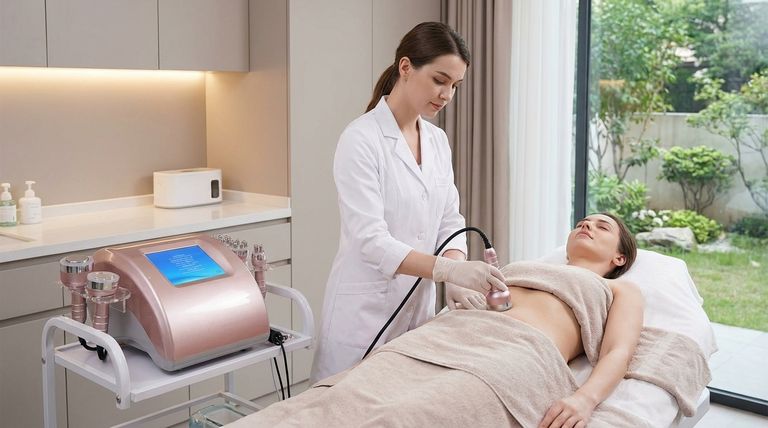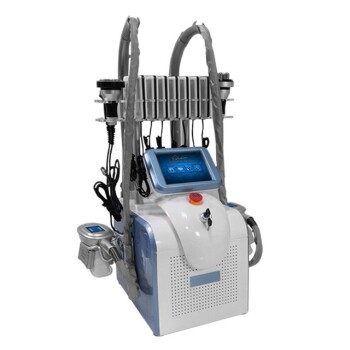In short, ultrasonic fat cavitation is generally considered safe when performed by a trained and qualified professional. The procedure is non-invasive, meaning it does not require surgery, and most people experience only minor, temporary side effects like redness, mild bruising, or a feeling of warmth in the treated area.
The safety of ultrasonic fat cavitation is less about the technology itself and more about the skill of the operator and the suitability of the candidate. While the device is capable of producing results, its safe application is entirely dependent on professional expertise.

How Does Ultrasonic Cavitation Actually Work?
To understand the safety profile, you first need to understand the mechanism. This isn't a magic wand that "melts" fat away; it's a specific biophysical process.
The Science of Sound Waves
Ultrasonic cavitation uses low-frequency ultrasound waves, which are outside the range of human hearing. The device's handpiece is applied to the skin and sends these sound waves deep into the tissue.
The "Cavitation" Effect
These sound waves create intense pressure changes in the interstitial fluid surrounding the fat cells. This pressure change causes microscopic bubbles to form and rapidly implode, creating a shockwave.
This shockwave is the key. It is strong enough to rupture the membrane of the fat cells (adipocytes) without damaging surrounding tissues like skin, nerves, or blood vessels.
What Happens to the Fat?
Once the fat cell is broken, its contents—primarily triglycerides—are released into the fluid between the cells. From there, your body's lymphatic system takes over, transporting these fatty acids to the liver to be processed and eliminated from the body.
Evaluating the Safety Profile
Because this procedure relies on the body's natural waste-clearing processes, its safety is generally high, but risks do exist.
Common and Expected Side Effects
The most common side effects are mild and resolve on their own within a few hours to a few days. These include:
- Redness and warmth from increased blood circulation.
- Mild bruising if small capillaries are affected.
- Slight discomfort during the procedure, often described as a buzzing sound.
Who Should Avoid This Procedure?
This treatment is not for everyone. Individuals with certain conditions (contraindications) should not undergo ultrasonic cavitation, as it can pose serious health risks. These include:
- Pregnancy or breastfeeding
- Liver or kidney disease
- Heart conditions or having a pacemaker
- Metal implants (like IUDs or plates) in the treatment area
- Active cancer or skin disease in the area
Understanding the Trade-offs and Limitations
Objectivity requires acknowledging that this procedure is not a cure-all. Understanding its limitations is key to having a safe and positive experience.
It's Not a Weight Loss Tool
Ultrasonic cavitation is a body contouring procedure, not a weight loss solution. It is designed to target small, stubborn pockets of fat that are resistant to diet and exercise. It will not produce significant changes on the scale.
The Critical Role of the Practitioner
The single most important factor for both safety and effectiveness is the qualified professional performing the treatment. An untrained operator can use incorrect settings, leading to poor results, skin burns, or discomfort. A true professional will conduct a thorough consultation to ensure you are a good candidate.
Results Depend on Your Lifestyle
Since the procedure relies on your body to process the released fat, the results are directly impacted by your lifestyle. Proper hydration is essential to help the lymphatic system function, and a healthy diet prevents the processed fat from simply being stored again.
Making a Safe and Informed Decision
To ensure you get the best and safest outcome, you must approach this decision with clear goals and a critical eye.
- If your primary focus is safety: Your top priority must be vetting the provider. Ask about their specific training in ultrasonic cavitation, how many procedures they've performed, and check for certified credentials.
- If your primary focus is effectiveness: Commit to the full process. This means attending all sessions in your treatment plan and supporting your body's efforts with excellent hydration, a clean diet, and regular exercise.
- If you are looking for significant weight loss: This procedure is not the right tool. Consult a healthcare professional about comprehensive strategies like nutrition planning and medical weight management programs.
Ultimately, ultrasonic cavitation can be a safe tool for targeted fat reduction when your expectations are realistic and your provider is expertly qualified.
Summary Table:
| Safety Factor | Key Consideration |
|---|---|
| Overall Safety | Generally safe when performed by a qualified professional. |
| Procedure Type | Non-invasive, no surgery required. |
| Common Side Effects | Temporary redness, mild bruising, warmth. |
| Key Risk Factor | Operator skill and candidate suitability. |
| Who Should Avoid | Pregnant women, individuals with liver/kidney disease, heart conditions, or metal implants in the area. |
Ensure the safety and effectiveness of your body contouring treatments. BELIS specializes in professional medical aesthetic equipment, including advanced ultrasonic fat cavitation machines designed for safety and superior results. Our devices empower medical aesthetics clinics and premium beauty salons to offer trusted, non-invasive treatments.
Contact our experts today to learn how BELIS equipment can enhance your service offerings and build client trust.
Visual Guide

Related Products
- Ultrasonic Cavitation Radiofrecuency Machine for Body Slimming
- Cryolipolysis Fat Freezing Machine and Ultrasonic Cavitation Device
- Cryolipolysis Fat Freezing Machine Ultrasonic Cavitation Fat Reducing Device
- EMSlim Body Sculpting Machine EMS Body Slimming Machine
- EMS Body Sculpting Slimming Machine EMSlim Body Slimming Machine
People Also Ask
- What are the negative side effects of cavitation? Understanding the Risks for Your Practice
- When should you not use a cavitation machine? Critical Safety Guidelines for Aesthetic Treatments
- How many RF sessions do you need to see results? Achieve firmer, tighter skin with a personalized plan.
- What does a cavitation machine do for your body? Sculpt Your Contours Without Surgery
- Do fat cavitation machines really work? A Professional's Guide to Body Sculpting



















